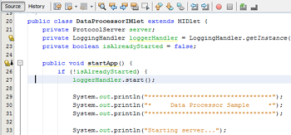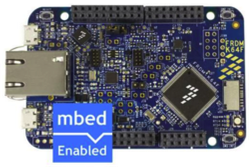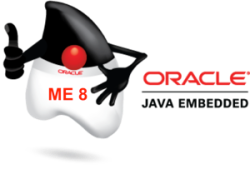You are currently browsing the tag archive for the ‘Java ME SDK 8’ tag.
Tag Archive
Update on tooling with Java ME Embedded 8.1 Developer Preview
10/03/2014 in Embedded | Tags: "Developer Preview", FRDM-K64F, Java ME, Java ME Embedded 8, Java ME SDK 8 | Leave a comment
Quick update on the Java ME Embedded 8.1 Developer Preview that was released on Sunday:
Some developers have reported problems with connecting the FRDM-K64F to the ME SDK Device Manager over USB as well as the inability to set static IP addresses on the FRDM-K64F. We have seen this as well and are working on fixing the issues.
In the meantime, the most reliable way to connect the FRDM-K64F to the ME SDK 8.1 EA #3 is to use DHCP addressing on the FRDM-K64F and then connect to the Device Manager via IP.
Update:
Also, please be sure to NOT run the ME SDK Device Manager and the manual proxy at the same time – they will conflict. To get started it is best to just use the ME SDK 8.1 (make sure to use version EA #3) and connect via the Device Manager to make sure tooling works that way.
Cheers,
— Terrence
Press Release: Oracle Introduces the Latest Release of Oracle Java ME Embedded
09/29/2014 in Embedded | Tags: "Developer Preview", "Java ME 8", Ardunio, ARM, Cortex-M, download, Early Access, Java Embedded, Java ME Embedded 8, Java ME SDK 8, mbed, microcontroller, OTN, small | Leave a comment
On the heels of the release yesterday, here is the official press release:
Oracle Introduces the Latest Release of Oracle Java ME Embedded, with supporting quotes by V2COM and Telit.
Cheers,
— Terrence
Now available: Java ME 8.1 in 190 KB RAM
09/28/2014 in Embedded | Tags: "Developer Preview", "Java ME 8", Ardunio, ARM, Cortex-M, download, Early Access, FRDM-K64F, Java Embedded, Java ME Embedded 8, Java ME SDK 8, mbed, microcontroller, OTN, small | Leave a comment
Update:
- 10/8/14: JavaOne CON6222 presentation and sample code available
- 10/3/14: Update on tooling with Java ME Embedded 8.1 Developer Preview
Announcing Oracle Java ME Embedded 8.1 Developer Preview for Freescale FRDM-K64F
Java ME 8 is purpose-designed to bring Java-powered software intelligence to a wide range of embedded devices – scaling all the way down to resource-constrained micro-controllers. Since the release of Java ME 8 a few months ago we’ve seen tremendous interest in the industry in leveraging Java as the software platform to bring the next generation of functionality and flexibility to embedded systems and the Internet of Things.
Today, we are accelerating the adoption of Java ME 8 with a Developer Preview of Oracle Java ME Embedded 8.1 on ARM Cortex-M4 devices, in collaboration with Freescale and ARM.
What is it?
The Freescale FRDM-K64F is built around the Kinetis K64F with 120 MHz, 256 KB RAM/1 MB Flash, running ARM mbed OS and with an Arduino form-factor and pin-out. A popular prototyping platform for both the mbed and Arduino communities, now joining forces with the Java ecosystem.
The Oracle Java ME Embedded 8.1 Developer Preview on FRDM-K64F offers:
- A feature-rich and optimized Java ME 8 runtime in 190 KB RAM, enabling highly functional Java Embedded applications on single-chip micro-controller systems
- Out-of-the-box support for Java 8 language, core APIs, networking, device I/O, storage, and more
- Simple installation with a complete and ready-to-run binary, just copy it onto the device
- Rich development and tooling via Java ME SDK 8.1 and NetBeans 8 IDE
- Complements existing Java ME 8 platforms such as Raspberry Pi, scaling Java ME 8 from large to small
- Ideal for evaluation and prototyping of small embedded & IoT solutions
What next?
Presentation: For more information and background have a look at the short slide deck “Introduction to Oracle Java ME Embedded 8.1 Developer Preview”.
Download: The Java ME Embedded 8.1 Developer Preview and the corresponding Java ME SDK 8.1 Early Access #3 are available NOW on the Oracle Technology Network (OTN).
Documentation: The release comes with Release Notes and Getting Started Guide for FRDM-K64F. There is also a full set of Java ME 8 documentation.
So grab a FRDM-K64F board from your favorite electronics shop or distributor, download the Developer Preview, and get started! Head over to the Java ME Embedded OTN forum to ask questions.
And finally, if you are watching the JavaOne 2014 Java Technical Keynote keep your eyes peeled for those little FRDM boards running Java ME 8 … 😉
Cheers,
— Terrence
Java ME 8: Getting Started with Samples and Demo Code
05/02/2014 in Embedded | Tags: "Java ME 8", demo, Getting Started, Java ME Embedded 8, Java ME SDK 8, NetBeans, samples | 2 comments

Now that Java ME 8 is released a lot of people trying it out and are asking for sample code and demos. We’ve got you covered:
1) The first place you should go is the ”Java ME SDK 8 Developer Guide“. This is your one-stop-shop for getting started with Java ME 8 development on your PC (no external hardware required). Chapter 2 is “Creating a Java ME SDK 8 Sample Project”, and part IV is all about “Sample Applications”.
2) Next, you will want to browse the “Java ME Embedded Developer Guide”, which covers important topics for developing Java ME 8 embedded applications. Chapter 5 talks about “General Purpose I/O”, chapter 6 about “Working with the I2C Bus”, and chapter 7 about “The Serial Peripheral Interface (SPI) Bus”.
3) The Java ME SDK 8 comes with a whole set of ready-to-go demo applications. After installing the Java ME SDK 8 and NetBeans 8, start up NetBeans and make sure the “Java ME SDK Demos” plug-in is installed and active (this should be the default case). Then, create a new project and in the New Project dialog look under the “Samples > Java ME SDK 8.0” folder for a number of complete Java ME Embedded 8 demo projects.
4) Finally, check out the “Getting Started Guide (Raspberry Pi)” and the “Getting Started Guide (Qualcomm IoE)” for information on how to run apps on these platforms, including access to real-world peripherals via GPIO, I2C, SPI, UART, and others.
We are also working on additional demos and sample code – stay tuned for more information on this.
And remember to head over to the OTN Java ME Embedded forum to browse and ask questions – we are monitoring this forum on a regular basis.
Cheers,
— Terrence
Java ME 8 Released!
04/30/2014 in Embedded | Tags: "Java ME 8", "jsr 360", "jsr 361", iot, Java 8, Java Embedded, Java ME Embedded 8, Java ME SDK 8, M2M, OJPI, release | 6 comments
Welcome to Java ME 8!
Last month, Java 8 was launched. Last week, the Java Micro Edition (ME) 8 specifications were approved.
Today, we are announcing the general availability (GA) of the Java ME 8 release.
This release is the culmination of a two-year effort driving a major update of the Java ME technology as a modern embedded software platform, purpose-built as a foundation for new services in the Internet Of Things. We are closely collaborating with industry partners and are seeing strong interest and adoption in Java ME 8 across a number of markets such as wireless modules, automotive, smart sensors, healthcare, industrial automation, smart energy, logistics, and others.
Top 10 Features of Java ME 8
Java ME 8 has been designed to enable advanced embedded software intelligence and increased product value for a wide range of use cases and solutions while maintaining very low system requirements. Top 10 features include:
- Aligned with Java 8 for efficient development
- Designed for Embedded
- Highly portable and scalable
- Consistent across devices
- Advanced application platform
- Modularized software services
- Client domain partitioning
- Direct access to hardware devices
- Compatible with standard APIs
- Enhanced embedded tooling
For more information, please see the screencast “Java ME 8: Top 10 Features”.
What We Are Releasing Today
Todays release comprises of several of components:
Java ME 8 TCK (Technology Compatibility Kit) and RI (reference implementation):
- Java ME Connected Limited Device Configuration (CLDC) 8 (JSR 360)
- Java ME Embedded Profile (MEEP) 8 (JSR 361)
Oracle Java ME Embedded 8 product implementations and tooling:
- Oracle Java ME Embedded 8 product implementations for several embedded platforms (see below)
- Oracle Java ME SDK (Software Development Kit) 8 for embedded software development
Oracle Java Platform Integrator (OJPI) releases for Java ME Embedded 8:
- Enables Oracle partners to deliver value-add products and services based on Java ME Embedded 8 (OJPI information)
Support for the following platforms:
- Raspberry Pi Model B (based on ARM11/Linux)
- Qualcomm IoE Development Platform (based on ARM9/Brew MP)
- Windows x86 device emulation environment (for rapid prototyping/development)
We are also planning on bringing Oracle Java ME 8 to additional platforms such as micro-controller-based devices – please stay tuned.
Where to Find More Information
For more information, please see the following links:
- Oracle Java ME Embedded 8 data sheet
- Oracle Java ME SDK 8 data sheet
- “Java ME 8 Deep Dive” technical presentation
- Java 8 Launch screencasts on Java ME 8 on a variety of different technical topics
- Java Magazine March issue with several articles on Java ME 8
- Video interviews with Oracle executives and Oracle partners on Java Embedded and IoT topics
- General information on Oracle’s Internet of Things Platform, including videos, white papers, and brochures
Getting Started with Java ME 8
To get started developing with Java ME 8, download the Oracle Java ME SDK 8 which comes with a built-in Java ME 8 device emulation environment for rapid development plus great documentation to get you started.
Once you’re ready to move on to real hardware such as Raspberry Pi or the Qualcomm IoE platform, download the ready-to-run Oracle Java ME Embedded 8 platform binaries.
Go here for the full set of Oracle Java ME 8 documentation, including:
- Release Notes
- Getting Started Guides for all platforms
- ME SDK Developer Guide
- Java ME Embedded Developer Guide
- API documentation
Finally, head over to the Java ME Embedded Forum to ask questions and get involved. And follow @javaembedded or @terrencebarr to stay in touch.
What Next?
Java ME 8 brings exciting new possibilities to the embedded software space. Get started today and stay tuned for more to come!
Cheers,
— Terrence



Recent Comments